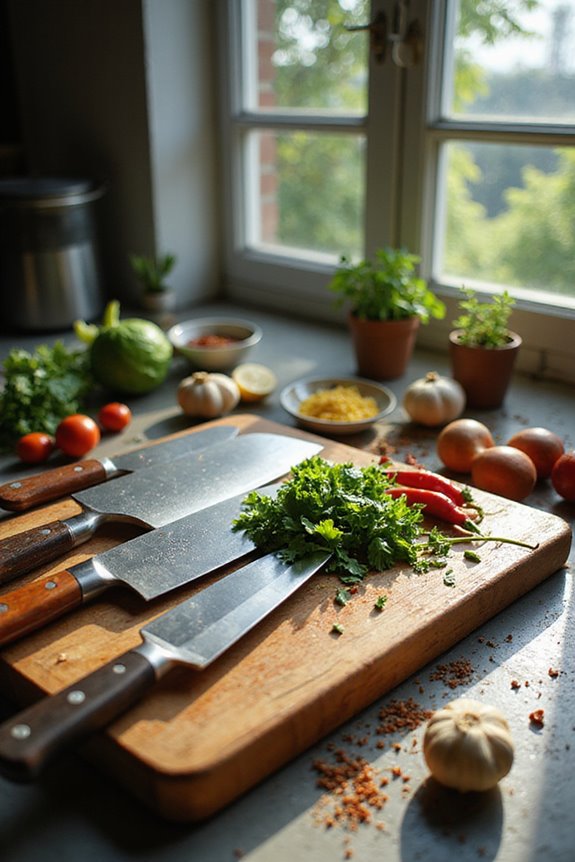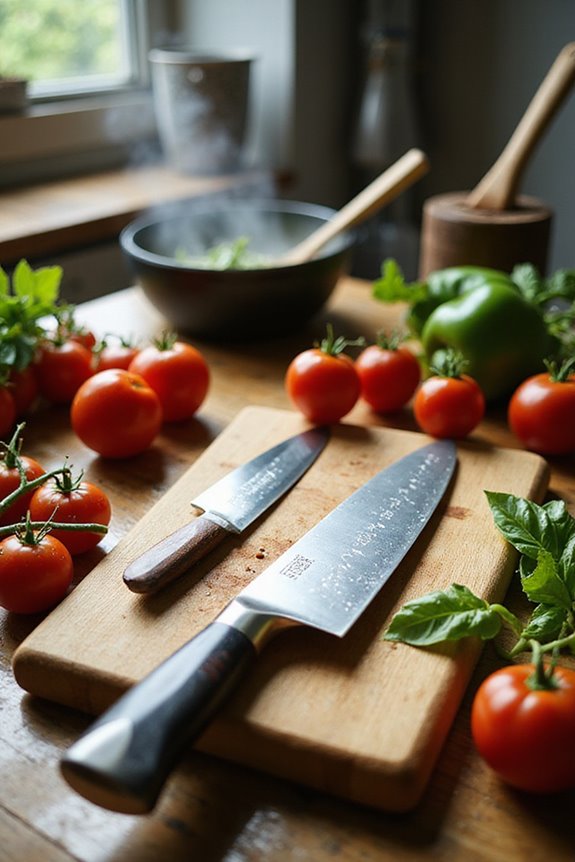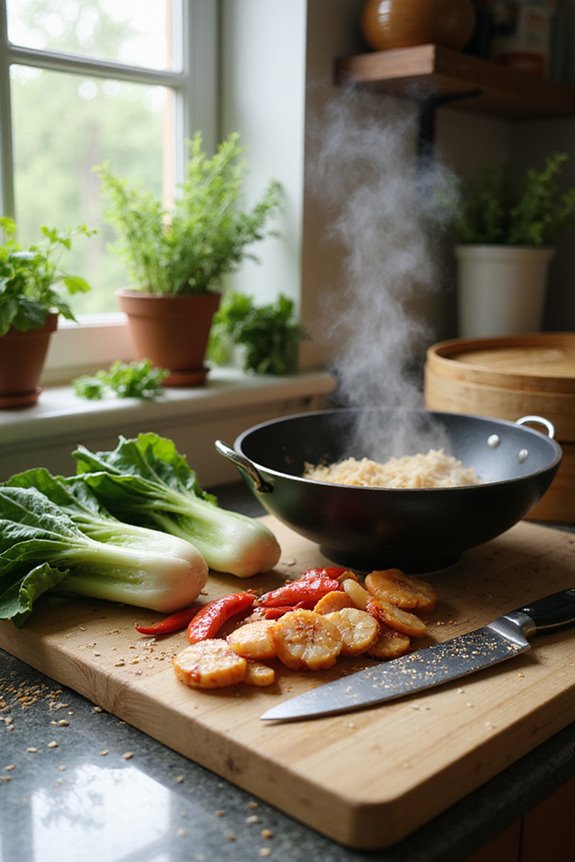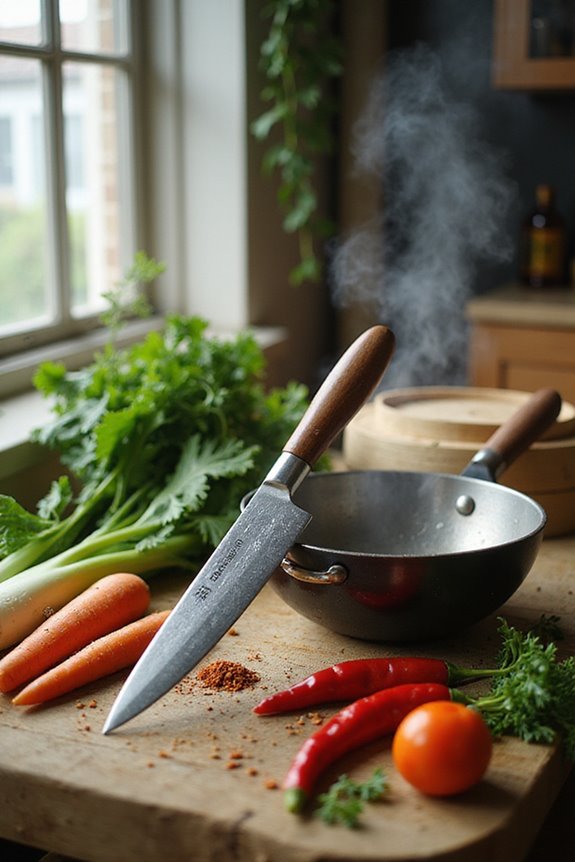As an Amazon Associate, we earn from qualifying purchases. Some links may be affiliate links at no extra cost to you. Although our opinions are based on curated research, we haven't used these products. Articles generated with AI.
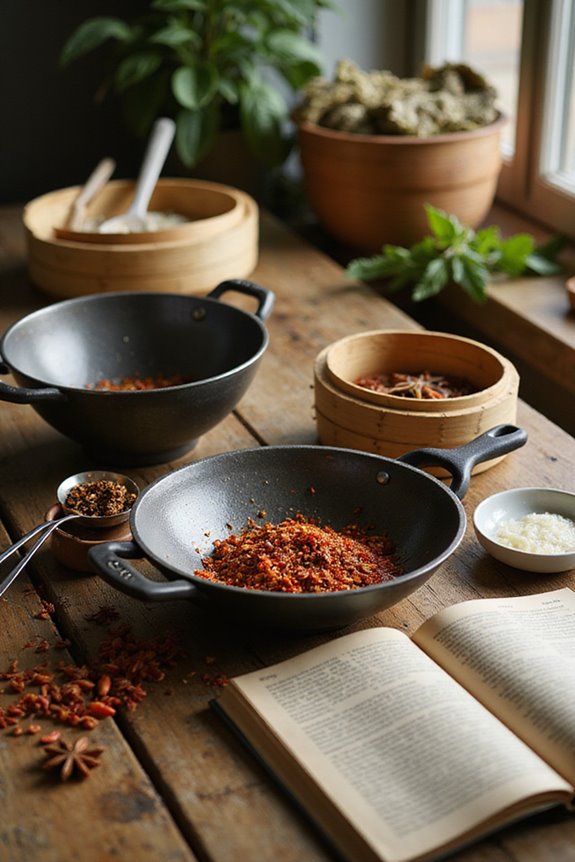
3 Best Vertical Growing Systems for Maximizing Your Garden Space
To maximize your garden space, consider the Gardyn Studio Hydroponics Kit, which can grow up to 16 plants in just 1.4 sq. ft. The Hydroponics Growing System Kit boosts growth rates by 50%, ideal for beginners. Finally, the 30-Plant Vertical Garden Planter utilizes soilless technology for superior results. Each of these systems is designed for space efficiency, water savings, and year-round production, making them perfect for urban settings. Keep exploring to find the right fit for you!
Key Takeaways
- Gardyn Studio offers advanced AI monitoring, maximizing growth for 16 full-sized plants while occupying only 1.4 sq. ft. of space.
- The Hydroponics Growing System Kit boosts growth rates by 50%, ideal for compact spaces like balconies or windowsills.
- Hydroponic Growing System accommodates up to 30 plants with efficient vertical design and timed watering to conserve water effectively.
- Vertical growing systems save 90-95% water compared to traditional methods, promoting sustainable urban gardening.
- Automated features make these systems suitable for beginners, allowing year-round harvesting with minimal maintenance.
Gardyn Studio Hydroponics Growing System Kit & Vertical Indoor Garden Planter
Gardyn Studio Vertical Hydroponics Growing System Kit - 16 Non-GMO Plants, Herbs, Vegetables - Tower...
- COMPACT HYDROPONIC SYSTEM: The Gardyn Studio hydroponics growing system kit grows 16 full-sized indoor plants in only 1.4 sq. ft., making it perfect for apartments, small...
- EASY INDOOR GARDENING: Designed for effortless care, this hydroponic planter uses advanced LED lights that mimic natural sunlight while a built-in 4-gallon tank...
- AI-POWERED SMART GARDEN: Gardyn Studio features Kelby, your AI plant coach, who monitors growth through sensors and a high-resolution camera to ensure your hydroponic...
If you’re looking for a convenient way to grow fresh herbs and vegetables in limited indoor spaces, the Gardyn Studio Hydroponics Growing System Kit is an excellent choice. This innovative hydroponic system allows you to cultivate 16 full-sized plants in just 1.4 square feet, making it perfect for compact living. With advanced LED lights that imitate sunlight, your plants thrive in various rooms, thanks to its user-friendly design and a QR code for easy app setup. Plus, its AI-powered monitoring optimizes growth, helping you enjoy fresh produce with minimal fuss and sustainable practices, using 95% less water than traditional gardening.
Best For: Individuals seeking to grow fresh herbs and vegetables in small indoor spaces with minimal effort.
Pros:
- User-friendly setup with QR code access for easy app integration and video instructions.
- AI-powered monitoring provides real-time notifications and optimizes plant growth for successful gardening.
- Sustainable gardening with zero pesticides and 95% less water usage compared to traditional gardening methods.
Cons:
- Some users report limitations in app functionality and additional subscription costs for certain features.
- Suggestions for improvement include better placement of temperature and humidity sensors to enhance monitoring.
- Initial cost may be a concern for budget-conscious individuals looking for gardening solutions.
Hydroponics Growing System Kit for Indoor Gardening
YUDNLIB Hydroponics Growing System kit, 30 Pods Vertical Hydroponic Tower for Smart Indoor Home...
- 【Large Water Tank】——Equipped with a 10L (20 lb) water tank, it has water level marks inside and a water level gauge outside to ensure precise water management. A...
- 【Hydroponic System】——This efficient hydroponic tower increases hydroponic growth rates by 50%, and the automated system makes it perfect for beginners, providing...
- 【Water-saving soilless cultivation】——This hydroponic gardening system replaces traditional soil planting and uses a self-circulating irrigation process to save...
The Hydroponics Growing System Kit for Indoor Gardening stands out as an excellent choice for smart home gardening enthusiasts who want to maximize their yields in limited spaces. This efficient hydroponic tower boosts growth rates by 50%, making it perfect for urban environments. It features an automated system that’s low-maintenance, ideal for beginners. Equipped with a 10L water tank and a built-in pump, it saves 90-95% of water compared to traditional methods. Its compact design fits easily on balconies or windowsills, allowing for year-round harvesting of fresh fruits and vegetables, ensuring your family enjoys nutritious homegrown produce all year long.
Best For: Smart indoor gardening enthusiasts seeking an efficient, sustainable, and space-saving solution for growing fresh produce.
Pros:
- Boosts growth rates by 50%, allowing for more yields in less time.
- Automated, low-maintenance system ideal for beginners and busy lifestyles.
- Compact vertical design maximizes space, making it perfect for urban living.
Cons:
- Initial setup may be daunting for complete novice gardeners.
- Limited capacity of the water tank may require frequent refills in larger setups.
- May need supplemental lighting for optimal growth in low-light conditions.
Hydroponic Growing System Vertical Garden Planter (30-Plant)
Sale
Hydroponic Growing System Outdoor Indoor Vertical Garden Home Gardening System Vertical Garden...
- ▲ SOILESS: Hydroponics is used instead of traditional soil cultivation, so the automatic top-down timed watering cycle makes better use of water and reduces water waste...
- ▲OUTDOOR OR INDOOR GROWING: Whether you grow indoors or in a sunny spot in your backyard or balcony, you can offer soil-free options for indoor and outdoor gardening...
- ▲EASY TO MOVE & SPACE-SAVING: our planting tower is compact and can be placed in the kitchen, living room, etc. to meet different layout forms and create a beautiful...
Experience the ease of growing your own vegetables, fruits, and flowers with the Hydroponic Growing System Vertical Garden Planter, designed for those who want to maximize space while enjoying home gardening. This indoor and outdoor unit can accommodate up to 30 plants and features an efficient vertical design, ideal for limited spaces. Weighing just 2.8 kg, it’s easy to move and set up. The soilless hydroponic technology guarantees superior growth, with a timed watering cycle that conserves water. Although assembly is required, users appreciate its productivity and compactness, making it a great addition to your gardening toolkit.
Best For: Gardening enthusiasts looking to maximize space while growing vegetables, fruits, and flowers at home.
Pros:
- Efficient vertical design allows for cultivation in limited spaces.
- Soilless hydroponic technology promotes superior plant growth and conserves water with an automated watering cycle.
- Lightweight and compact, making it easy to relocate and set up.
Cons:
- Requires assembly, which may be challenging for some users.
- Users have reported difficulties with harvesting and starting seeds effectively.
- Customer ratings suggest variability in user experience, with a moderate average rating of 4.0 stars.
Factors to Consider When Choosing Vertical Growing Systems

When choosing a vertical growing system, you’ll want to think about several key factors. Consider how much space you have and how many plants you want to grow, as well as the ease of assembly and power needs. Water management is another important aspect that can greatly impact your gardening success.
Space Efficiency
Space efficiency is an essential factor to take into account when choosing vertical growing systems for your garden. These systems are designed to maximize limited space, often requiring just a footprint of 1.4 sq. ft. or less, perfect for small areas. With their tower designs, they take advantage of vertical space, making them ideal for urban gardening on balconies, terraces, and sunny windowsills. Many vertical systems can accommodate a remarkable number of plants—sometimes up to 30—compared to traditional gardening. By utilizing hydroponic technology, you can also experience growth rate increases up to 50%, which means you’ll produce more in the same compact space. Furthermore, the compact nature of these systems allows for year-round indoor gardening.
Plant Capacity
Choosing the right plant capacity is vital for maximizing the benefits of vertical growing systems. When you pick a system, take into account how many plants it can accommodate, as some can host just a few while others can support over 30. A higher capacity system allows you to grow a variety of fruits, vegetables, and flowers year-round, leading to increased yields. If you’re short on space, opt for compact designs that efficiently fit larger systems within smaller areas. Be sure to take into account the growth rates; certain systems can boost growth by up to 50% compared to traditional gardening methods. It’s vital that irrigation features can manage the needs of your chosen plant capacity, ensuring an effective growing experience.
Water Management
Effective water management is essential if you’re planning to maximize the efficiency of your vertical growing system. These systems can save 90-95% of water compared to traditional soil gardening, making them more sustainable. Look for vertical setups with built-in pumps that provide self-circulating irrigation, ensuring consistent moisture for your plants’ roots. Many systems include water tanks equipped with internal level marks and external gauges, allowing you to monitor water levels precisely. Automated watering cycles are also common, delivering timed water to plants, which reduces waste and promotes ideal growth conditions. Regularly check water quality and nutrient levels; this can prevent issues like overwatering or nutrient deficiencies, helping your plants thrive efficiently.
Ease of Assembly
When you’re considering a vertical growing system, the ease of assembly can make a significant difference in your gardening experience. Start by evaluating how many components the system has; fewer parts typically mean a quicker setup. Look for systems that provide clear instructions or video tutorials to simplify the process. Lightweight components are easier to handle, making positioning during assembly less cumbersome. Some systems come with pre-assembled sections, cutting down both complexity and time dramatically. Finally, check if you’ll need standard tools for assembly or if the system is designed to require no tools at all, which can really ease the setup for beginners. Ultimately, a user-friendly system will keep you focused on your plants, not assembly.
Power Requirements
Setting up your vertical growing system doesn’t just end with assembly; understanding the power requirements is equally essential for successful gardening. Many systems need a reliable power source for LED lights, pumps, and sensors, so access to standard electrical outlets is vital. Check the voltage range, as most hydroponic systems operate between 110-240V, ensuring compatibility with your local power supply. If you’re using AI technology for monitoring, a stable 2.4 GHz Wi-Fi connection is necessary. Be mindful of power consumption; advanced models often use more energy for operation. Consider systems with backup power solutions or battery options to maintain plant health during outages, making these features key to your gardening success.
Light Requirements
Understanding light requirements is essential to the success of your vertical growing system, especially since plants rely on proper lighting for growth. Most systems use advanced LED lights that mimic sunlight, vital for indoor plants. You’ll want to provide your plants with around 12 to 16 hours of light per day to promote healthy photosynthesis. Consider customizing light schedules, as different plants may require varying intensities and durations of exposure. It’s also helpful to evaluate the light coverage area of your system, ensuring all plants receive adequate illumination without being overshadowed. Some hydroponic systems even integrate AI technology, automatically adjusting lighting based on each plant’s needs and growth stages, making your gardening experience more manageable and efficient.
Cost and Maintenance
While investing in a vertical growing system can be exciting, it’s important to carefully consider both the initial costs and ongoing maintenance expenses before making a decision. The upfront price can range considerably; budget-friendly systems exist alongside advanced models with added features that drive costs up. Don’t forget to account for maintenance—electricity for LED lights and pumps, plus any subscription costs for app services or plant food, can add up. Also, consider systems with self-circulating irrigation, as they can save up to 90-95% of water compared to traditional gardening. Finally, maintenance requirements vary; some systems are low-maintenance, while others demand more time and attention. Weigh these factors to choose wisely and maximize your investment.
Frequently Asked Questions
How Much Electricity Do Vertical Growing Systems Consume?
When it comes to electricity consumption, vertical growing systems vary widely. Typically, you’ll find that they consume anywhere from 100 to 600 watts, depending on the setup and type of lighting used. LED lights are popular for being energy-efficient, often drawing less electricity. To keep costs manageable, consider sizing your system and lighting according to your plants’ needs, ensuring you’re not overdoing it while still achieving healthy growth.
Can Vertical Gardens Be Used Outdoors as Well?
Yes, you can definitely use vertical gardens outdoors. They thrive on patios, balconies, and gardens, enhancing your space while maximizing plant growth. You’ll need to pick weather-resistant materials to withstand the elements. Additionally, make sure your plants get enough sunlight and water for peak growth. Consider factors like local climate and available sunlight when selecting plants, as these will impact your garden’s success. With careful planning, outdoor vertical gardens can flourish beautifully.
What Types of Plants Are Best for Vertical Growing Systems?
When choosing plants for vertical growing systems, consider herbs like basil and parsley, which thrive in smaller spaces. Additionally, leafy greens such as spinach and lettuce grow well and can be harvested repeatedly. Trailing plants, like strawberries and certain types of peas, maximize vertical space while offering bountiful yields. Finally, compact varieties of tomatoes and peppers are excellent choices, providing flavorful produce without overshadowing your vertical garden design.
How Often Should I Water My Vertical Garden?
Watering your vertical garden is like tuning a musical instrument; it needs the right balance to thrive. Check your plants daily, especially in warmer months, as they might dry out quicker. Generally, water when the top inch of soil feels dry. How often? It could be every 3-7 days, depending on the plants and climate. Adjust the frequency based on humidity, sunlight, and the specific needs of your plants to keep them healthy.
Do Vertical Growing Systems Require Special Nutrients?
Yes, vertical growing systems often need special nutrients. Since plants might have limited space for soil in these setups, choosing nutrient-rich solutions is essential. You’ll want to look for a balanced fertilizer that’s high in nitrogen, phosphorus, and potassium. Liquid nutrients are easy to apply, allowing you to adjust concentrations as needed. Monitoring your plants’ growth closely helps you tweak nutrient levels, ensuring peak health for your vertical garden.




